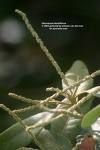Tan Oak Tree Information
Images of Tan Oak:






Tan Oak grows in the following 2 states and provinces:
California, OregonInformation about Tan Oak:
The Lithocarpus Densiflorus is commonly known as the Tan Oak, Tanbark-oak as well as Tanoak.
The currently accepted scientific name of tanoak is Lithocarpus densiflorus (Hook. & Arn.) Rehd. . Tanoak is the only North American representative of a large Asian genus. The genus Lithocarpus is considered a link between true oaks (Quercus) and the chinquapins and chestnuts (Castanopsis and Castanea), possessing characteristics of each . A shrubby growth form of tanoak, commonly known as shrub tanoak, has been recognized at the varietal level as Lithocarpus densiflorus var. echinoides (R. Br.) Ambrams.. Unless stated otherwise, this discussion pertains to the typical variety, L. densiflorus var. densiflorus.A major component of coastal mixed evergreen forests, tanoak is distributed from the Cascade Mountains of southwestern Oregon southward through the Klamath Mountains and California Coast Ranges to Ventura County . In northern California, tanoak ranges inland to the lower slopes of Mount Shasta and occurs intermittently along the west slope of the Sierra Nevada as far south as Mariposa County . Sierra stands are locally abundant in Butte and Yuba Counties . Recent inventories indicate that this hardwood comprises the dominant cover type over at least 861,000 acres (350,700 ha) in California . Shrub tanoak (var. echinoides) occurs in chaparral communities throughout the mountains of northern California and southern Oregon, becoming particularly abundant in the vicinity of Mount Shasta . Scattered populations also occur in the southern Coast Ranges and in the central Sierra Nevada .Self-perpetuating stands of tanoak are indicative of climax conditions in a number of communities within evergreen hardwood , mixed evergreen , redwood (Sequoia sempervirens) , and mixed conifer forests . Within mixed evergreen forests in southwestern Oregon, Atzet describes climax tanoak communities associated with warm, moist sites along the lower slopes of the Siskiyou Mountains. Even though most stands are currently dominated by a Douglas-fir (Pseudotsuga menziesii) overstory, Douglas-fir is a fire-maintained, seral component within these stands. Climax understory dominants within the tanoak series may include vine maple (Acer circinatum), Cascade holly grape (Berberis nervosa), poison-oak (Toxicodendron diversilobum), salal (Gaultheria shallon), vanilla leaf (Achlys triphylla), common prince's-pine (Chimaphila umbellata), and twinflower (Linnaea borealis).Some of the information provided here is attributed to:McMurray, Nancy E. 1989. Lithocarpus densiflorus. In: Fire Effects Information System, [Online]. U.S. Department of Agriculture, Forest Service, Rocky Mountain Research Station, Fire Sciences Laboratory (Producer). , available at the USDA Fire Effects Information System (FEIS) website